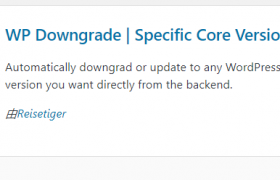猫叔平时喜欢钻研技术, 比如掌握了 SEO技术之后,我就没有停止过,对网站建设,运维,安全,还有服务器的维护都有了一定级别的深造,相信比专科的他们差不到哪里去。
还要wordpress 网站主题的开发,这一块也比较喜欢, 自己花猫大叔网站模板 被自己改了很多次。 有些地方感觉很完美,有些地方不是太理想。 总之,自己动手丰衣足食。
但是我不建议刚入门的朋友也学习自己搞,这样太浪费你的时间了。 有些东西还要外包比较好。

Wp主题模板制作教程 制作出一个漂亮的主题
Wp百科网主题模板制作教程 1
1、wordpress模板结构分析 1
2、制作一个可以运行的wordpress主题,修改style.css 1
3、制作出主题结构,index.php,header.php,footer.php,sidebar.php 2
4、修改header.php,footer.php 2
5、制作sidebar.php 2
6、制作index.php, 3
7、制作single.php页面,加入评论 3
8、制作page.php,archive.php,404.php 4
9、制作小工具 4
10、细节问题处理 4
1、wordpress模板结构分析
索引页模版:index.php
顶部:header.php
文章页面模板:single.php
边栏模板:sidebar.php
底部:footer.php
页面模版:page.php
搜索结果:search.php
文章归档:archive.php
评论:comments.php
404 页面模版:404.php
主题支持函数:functions.php
样式表:style.css
2、制作一个可以运行的wordpress主题,修改style.css
制作一个最简单的主题,只需要两个文件,index.php和style.css
第一步,准备静态页面
第二步,制作index.php和style.css
第三步,给style.css添加版权信息
第四步:把主题上传到空间中wordpress安装路径,wp-content/themes/下面,这里主题的文件夹名字必须是英文
第五步,在wordpress后台启用主题
先给style.css添加版权信息
/*
Theme Name: wordpress theme 01
Theme URI: http://www.wpbaike.com
Description: a simple bolg theme
Author: xixi
Author URI: http://www.wpbaike.com
Version: 1.0
Tags: white, blog, liweihui, blue
*/
Style.css路径调用:<?php bloginfo( ‘stylesheet_url’ ); ?>
主题缩略图名字:screenshot.png
3、制作出主题结构,index.php,header.php,footer.php,sidebar.php
把index.php拆分成header.php,footer.php和sidebar.phhp
<?php get_header();?>
<?php get_footer();?>
<?php get_sidebar();?>
4、修改header.php,footer.php
获取博客名字:<?php bloginfo(‘name’); ?>
获取博客描述:<?php bloginfo(‘description’); ?>
获取主页路径:<?php echo get_option(‘home’); ?>
获取主题存放路径:<?php bloginfo(‘template_directory’); ?>
<meta http-equiv=”Content-Type” content=”text/html; charset=<?php bloginfo( ‘charset’ ); ?>” />
<?php wp_head(); ?>
<title><?php if (is_home()||is_search()) { bloginfo(‘name’); } else { wp_title(”); print ” – “; bloginfo(‘name’); } ?> </title>
页面调用:
<?php wp_list_pages(‘sort_column=menu_order&title_li=&depth=2&include=’); ?>
分类目录调用:
<?php wp_list_categories(‘title_li=0&orderby=name&show_count=0&depth=2’); ?>
5、制作sidebar.php
最新文章:<?php wp_get_archives(‘type=postbypost&limit=20’); ?>
<?php $rand_posts = get_posts(‘numberposts=10&orderby=date’);foreach($rand_posts as $post) : ?>
<li><a href=”<?php the_permalink(); ?>”><?php the_title(); ?></a></li>
<?php endforeach;?>
日志标题太长超出,修改style.css,用到的代码:
text-overflow:ellipsis; white-space:nowrap; overflow:hidden;
随机文章:
<?php $rand_posts = get_posts(‘numberposts=10&orderby=rand’);foreach($rand_posts as $post) : ?>
<li><a href=”<?php the_permalink(); ?>”><?php the_title(); ?></a></li>
<?php endforeach;?>
热门文章:
<?php
$post_num = 10; // 设置调用条数
$args = array(
‘post_password’ => ”,
‘post_status’ => ‘publish’, // 只选公开的文章.
‘post__not_in’ => array($post->ID),//排除当前文章
‘caller_get_posts’ => 1, // 排除置頂文章.
‘orderby’ => ‘comment_count’, // 依評論數排序.
‘posts_per_page’ => $post_num
);
$query_posts = new WP_Query();
$query_posts->query($args);
while( $query_posts->have_posts() ) { $query_posts->the_post(); ?>
<li><a href=”<?php the_permalink(); ?>” title=”<?php the_title(); ?>”>
<?php the_title(); ?></a></li>
<?php } wp_reset_query();?>
标签云:
<?php wp_tag_cloud(‘smallest=8&largest=36&’); ?>
文章日期归档:
<?php wp_get_archives( ‘type=monthly’ ); ?>
分类目录:
<?php wp_list_cats(‘sort_column=name&optioncount=1&hierarchical=0’); ?>
友情链接:
<?php wp_list_bookmarks(‘title_li=&categorize=0&orderby=rand&limit=24’); ?>
6、制作index.php,
<?php if (have_posts()) : ?>
<?php while (have_posts()) : the_post(); ?>
<?php endwhile; ?>
<?php else : ?>
<?php endif; ?>
标题:<a href=”<?php the_permalink() ?>”><?php the_title_attribute(); ?></a>
调用文章内容:
<?php the_content(“Read More…”); ?>
调用文章内容摘要:
<?php the_excerpt(“Read More…”); ?>
作者:<?php the_author_posts_link(); ?>
日期:<?php the_time(‘F d, Y’) ?>
<?php the_time(‘m-d’) ?>
<?php the_date_xml()?>
评论调用:<?php comments_number(‘No Comment’, ‘1 Comment’, ‘% Comments’ );?>
文章所属分类:标签:<?php the_category(‘, ‘) ?>
上一页,下一页调用:
<div style=”float:left”><?php previous_post_link(‘« %link’); ?></div>
<div style=”float:right”><?php next_post_link(‘%link »’); ?></div>
7、制作single.php页面,加入评论
在single.php中调用<?php endwhile; ?>和<?php else : ?>中间让入
<?php comments_template(); ?>
8、制作page.php,archive.php,404.php
Page.php和single.php一样
archive.php和index.php一样
9、制作小工具
添加functions.php,
<?php
if ( function_exists(‘register_sidebar’) )
register_sidebar(array(
‘before_widget’ => ‘<div class=”sidebox”> ‘,
‘after_widget’ => ‘</div>’,
‘before_title’ => ‘<h2>’,
‘after_title’ => ‘</h2>’,
));
?>
在sidebar.php中模块最上面插入:
<?php if ( !function_exists(‘dynamic_sidebar’)
|| !dynamic_sidebar() ) : ?>
Sidebar最下面,添加<?php endif; ?>
10、细节问题处理
上一页,下一页调用:
<?php previous_posts_link(‘<span class=”next”>«上一页 </span>’) ?><?php next_posts_link(‘<span class=”previous”>下一页» </span>’) ?>
头部修改:
<meta http-equiv=”Content-Type” content=”text/html; charset=<?php bloginfo( ‘charset’ ); ?>” />
<?php wp_head(); ?>
Title调用改成下面这句:
<title><?php if (is_home()||is_search()) { bloginfo(‘name’); } else { wp_title(”); print ” – “; bloginfo(‘name’); } ?> </title>
首页文章只显示摘要<?php the_excerpt(“Read More…”); ?>
这里需要用到中文工具箱插件
1、最新文章
对应函数:<?php get_recent_posts(); ?>
详细说明:
get_recent_posts($no_posts = 5, $before = ‘<li>+ ‘, $after = ‘</li>’, $show_pass_post = false, $skip_posts = 0)
$no_posts:显示文章数,缺省为5条;
$before:每条记录前显示的文字,缺省<li>
$after:每条记录后显示的文字,缺省</li>
$show_pass_post:是(true)/否(false)显示保护了的文章,缺省否(false)
$skip_posts:跳过多少篇文章,缺省为0;
2、最新留言
对应函数:<?php get_recent_comments(); ?>
详细说明:
get_recent_comments($no_comments = 5, $before = ‘<li> ‘, $after = ‘</li>’, $show_pass_post = false)
$no_comments:显示回响数,缺省为5条;
$before:每条记录前显示的文字,缺省<li>
$after:每条记录后显示的文字,缺省</li>
$show_pass_post:是(true)/否(false)显示保护了的文章,缺省否(false)
如果希望在最新留言里不显示自己的回复。在get_recentcomments() 这个函数里找到这一句
post_status = ‘publish’
在后面 加上
AND comment_author != ‘管理员的昵称’
就可以了。(注意:引号是半角的)
拓展函数:
仅显示留言,不包括引用的函数<?php get_recent_comments_only (); ?>
仅显示引用(但包括trackback和pingback)<?php get_recent_trackbacks(); ?>
3、评论最多的文章
对应函数:<?php get_mostcommented(); ?>
详细说明:
// Get Top Commented Posts
get_mostcommented($limit = 5)
提示可以使用这个函数来实现热门文章的功能,即评论最多的文章。
4、发表评论最多的朋友
对应函数:<?php get_commentmembersstats(); ?>
详细说明:
get_commentmembersstats($threshhold = 5)
把代码里面的blogmaster改成你自己的名字,可以滤掉你自己的名字。下面加粗的那一项。
// Get Comments’ Members Stats
// Treshhold = Number Of Posts User Must Have Before It Will Display His Name Out
// 5 = Default Treshhold; -1 = Disable Treshhold
function get_commentmembersstats($threshhold = 5) {
global $wpdb, $tablecomments;
$comments = $wpdb->get_results(”SELECT comment_author, comment_author_url, COUNT(comment_ID) AS ‘comment_total’ FROM $tablecomments WHERE comment_approved = ‘1′ AND (comment_author != ‘网页教学网’) AND (comment_author != ”)GROUP BY comment_author ORDER BY comment_total DESC”);
$no = 1;
5、随机文章
对应函数: <?php random_posts(); ?>
详细说明:
random_posts ($limit = 5, $length = 400, $before = ‘<li>’, $after = ‘</li>’, $show_pass_post = false, $show_excerpt_in_title = true)
$limit:显示文章数,缺省5篇;
$length:摘要长度,缺省400;
$before:每条记录前显示的文字,缺省<li>
$after:每条记录后显示的文字,缺省</li>
$show_pass_post:是(true)/否(false)显示保护了的文章,缺省否(false)
$show_excerpt_in_title:是(true),摘要显示于文章链接的title;否(false),直接显示于页面;缺省是(true)
6、显示摘要
这一功能不需要在主题上调用函数,但需要模板文件支持!
某些情况下需要输出摘要,比如搜索结果、档案,还有 rss 输出,这样可以节省流量资源。但是,如果你的文章是中文的话,官方 WordPress 输出的其实并不是摘要,它只是把文章里的 html 代码过滤掉了,但所有文字都还是原样输出了。
但需要注意的是,你的主题里面应该有archive.php这个模板文件,而且这个模板文件使用的是the_excerpt()来调用内容而不是the_content().如果没有archive.php这个模板文件的话,你可以自己建立一个。具体方法为:
创建一个新文件:archive.php
把你主题里 index.php 中所有东西复制到 archive.php
保存 archive.php
在 archive.php 文件,把 the_content 改成 the_excerpt.
再次保存 archive.php 文件就可以了!
如果有archive.php模板文件的话,但是输出的是全文,你可以把the_content()替换为the_excerpt()就可以了!




